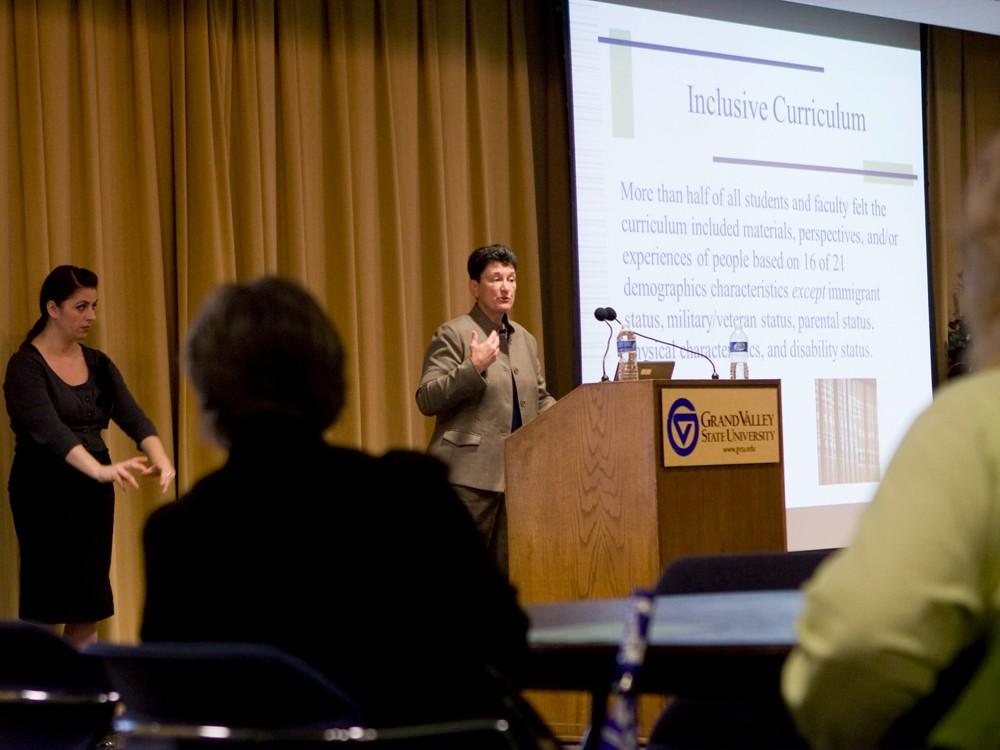University embarks on myGVSU action plan

GVL / Kate Kaurich Campus Climate Survey Results Speaker
Oct 10, 2011
During the first week of October, Sue Rankin, a senior research associate at the Center for Higher Education, visited Grand Valley State University to deliver the results of the myGVSU campus climate survey to the GVSU community. Now that the results have been made public, the university is readying for action and asking for help.
The myGVSU survey, conducted earlier this year, is the university’s fourth campus climate study and is designed to explore what it is like to live, learn and work at GVSU. Because the survey asked a variety of questions and had respondents across many different demographics, myGVSU co-chair and GVSU statistics professor Neal Rogness said there are plans to look at the result data “through many different lenses.”
To help put this expansive set of data to use, a subcommittee of the Inclusion and Equity Advisory Board, to be led by Jeanne Arnold, vice president of inclusion and equity, will develop an action plan based upon myGVSU’s findings. This subcommittee, which will analyze and prioritize the survey results, will be open to all members of the GVSU community interested in sharing their opinions and advice about the survey and its results.
“We are going to look for those action items; short-term things we can do,” Arnold said at one of the meetings presenting survey findings. “We probably have enough data to look at for the next several years.”
Rogness said one of the first “action items” for the subcommittee will be finding methods to make all of GVSU’s students, regardless of race, sexual orientation, religion or any other factor, feel as comfortable as possible at the university.
“These initial findings show that 88 percent of all GVSU community members who responded expressed comfort with the campus climate and 86 percent of all faculty and student respondents expressed comfort with the classroom climate,” he said. “Certainly, these high percentages are encouraging. Still, we need to better understand why others expressed less comfort in these areas. Also, some early themes that emerged are that some groups of individuals, such as people of color and LGBTQ respondents, expressed less comfort in some areas than their majority counterparts. We need to dialog about ways in which to make the university feel more welcoming and inclusive across all groups.”
In her presentation, Rankin agreed that some of GVSU’s key future challenges will be addressing racial tensions, homophobia, heterosexism and gender disparities.
However, Rogness was also encouraged that since the 2005 survey, the percentage of respondents who felt GVSU was committed to diversity and inclusion rose significantly.
He said in the 2005 study, 63, 67 and 61 percent of faculty, staff and student respondents, respectively, felt that GVSU was committed to diversity. Those numbers rose to 90, 94 and 88 percent in 2011. “It’s wonderful to see these numbers rise,” Rogness said. “I believe that GVSU has done a lot over the last six years to make the university feel more welcoming for all, and it’s encouraging to see that a high percent of GVSU stakeholders are recognizing these efforts.”
Past campus climate surveys have influenced on-campus changes such as the construction of the Women’s Center, the LGBT Resource Center, the Children’s Enrichment Center and the formation of the LGBT Faculty & Staff Association.
“These studies serve as markers for where the university is regarding this effort (to promote inclusion) and they allow us to discover opportunities for making GVSU an even better place than it already is,” President Thomas J. Haas said in a letter.
The executive summary of the myGVSU survey findings is currently available online at www.gvsu.edu/mygvsu. Anyone interested in helping develop the action plan is asked to contact Jessie Holland, executive secretary for inclusion and equity, at [email protected].

























